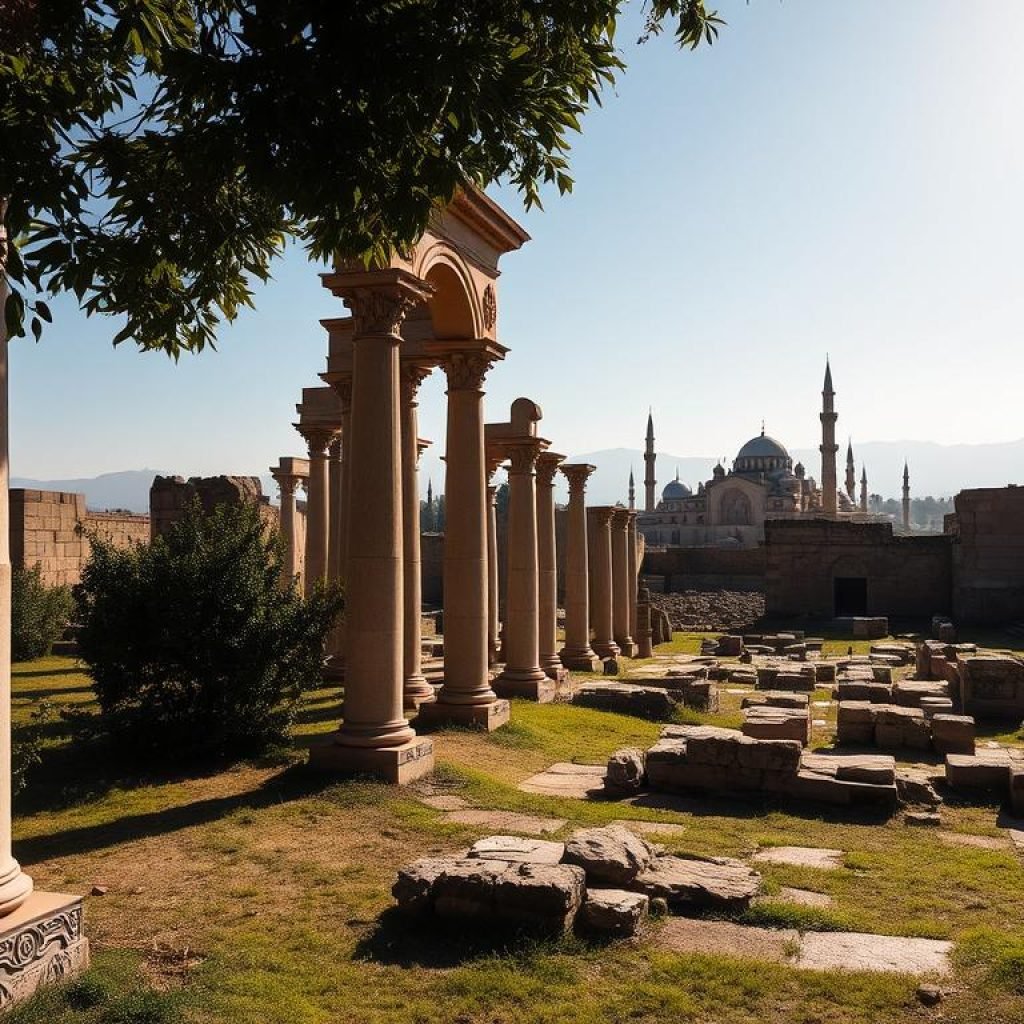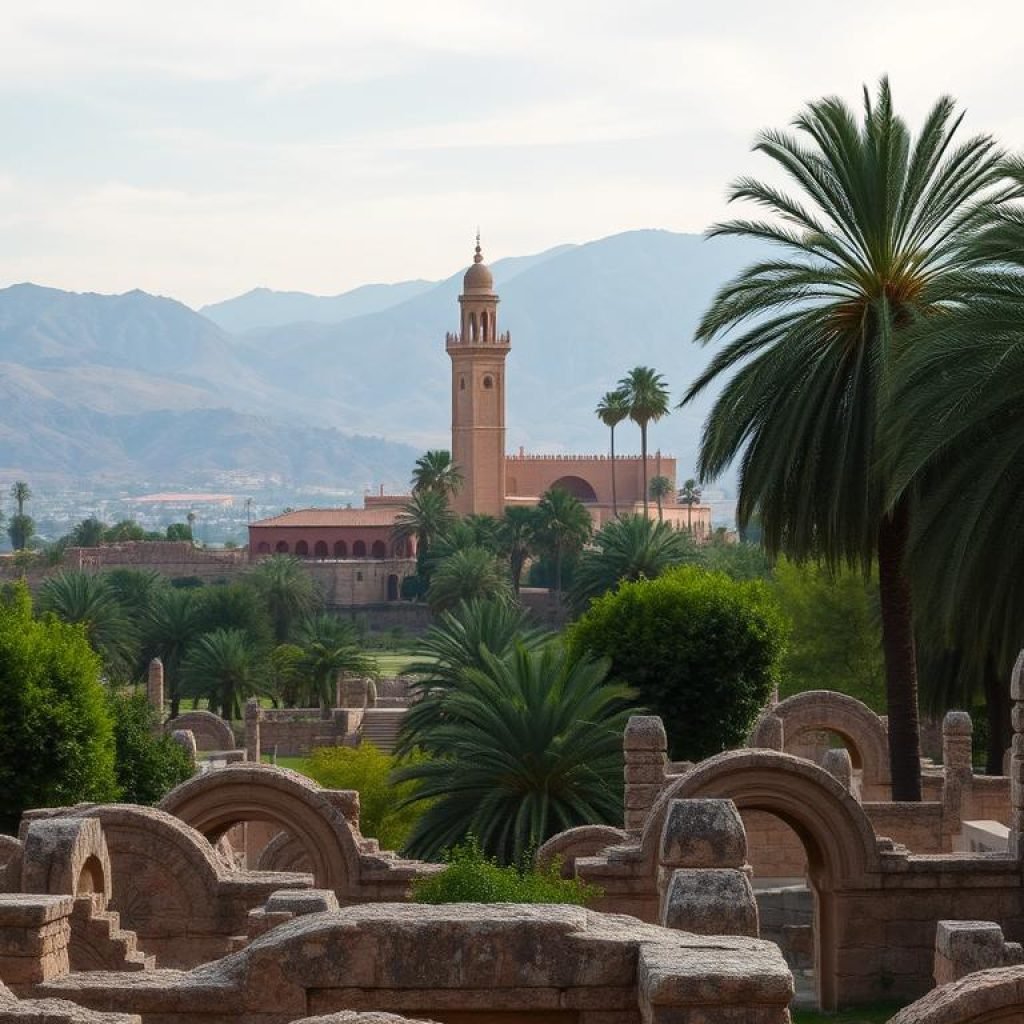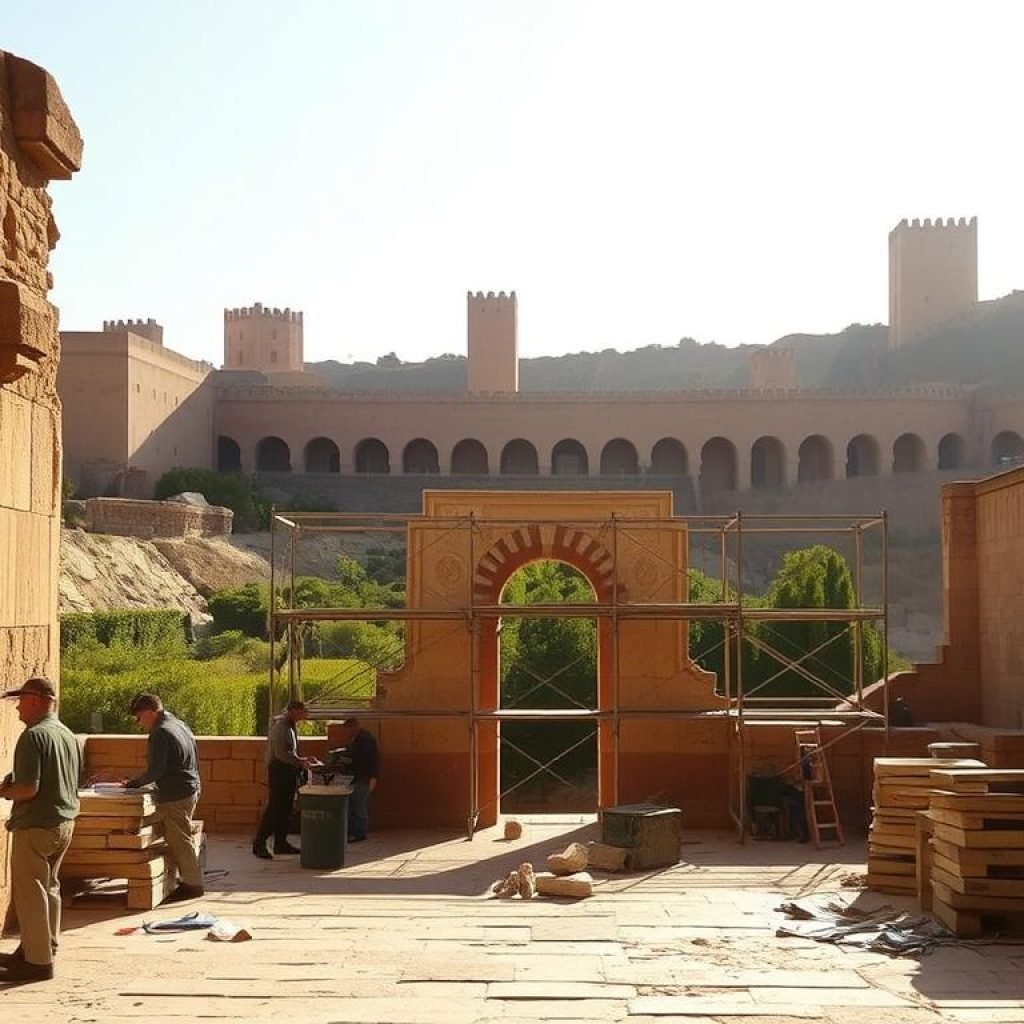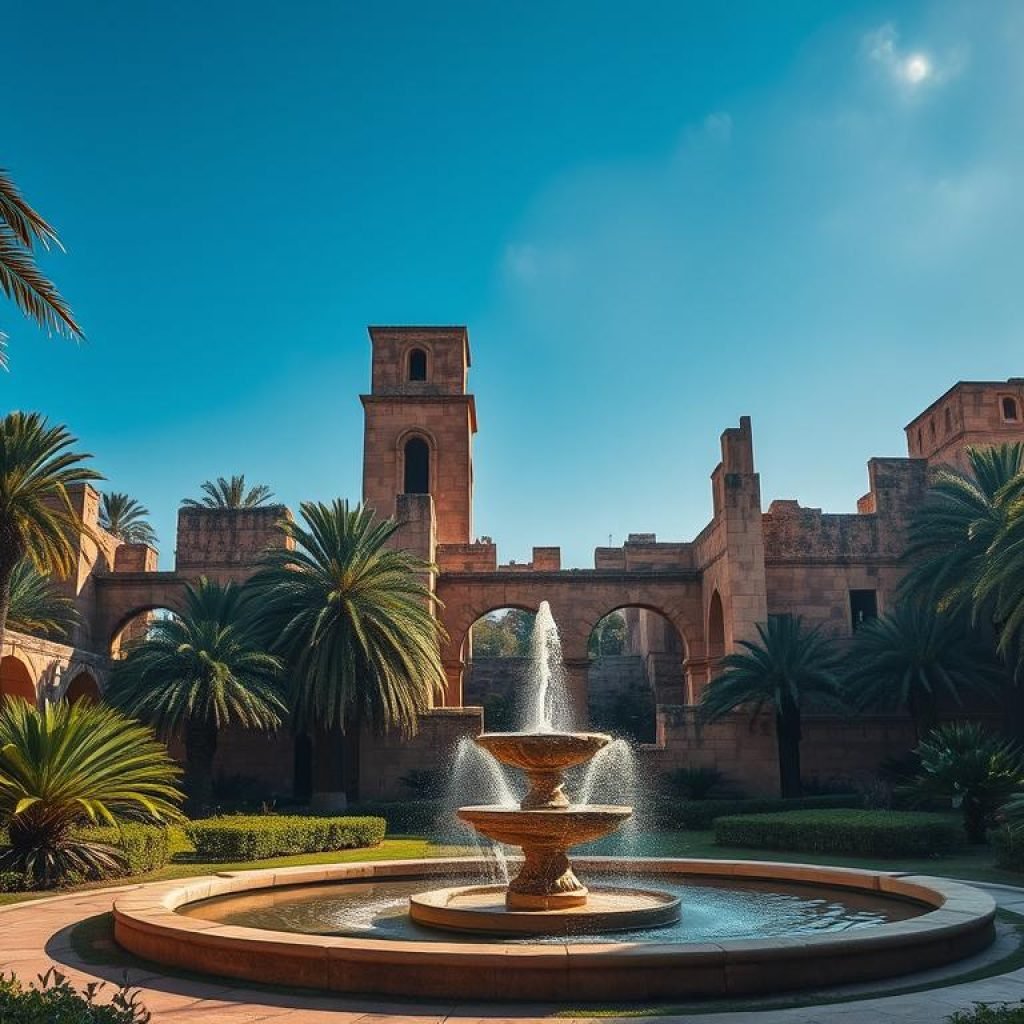Morocco is a country with a rich history, boasting nine UNESCO World Heritage sites. The Chellah Necropolis in Rabat is a key site, showing the mix of Roman and Islamic history. It features ancient ruins from the Roman era.
As a historical site, the Chellah Necropolis is a must-see for history lovers and travelers. It offers a unique look at Morocco’s cultural past.
Introduction to Morocco’s Historical Sites
Morocco’s historical sites, like the Chellah Necropolis, give a peek into the country’s diverse culture. They feature ancient ruins and landmarks that tell its complex story. From the ancient city of Fes to the Roman ruins of Volubilis, Morocco is full of historical wonders.
Key Takeaways
- Morocco is home to nine UNESCO World Heritage sites, including the Chellah Necropolis in Rabat, Morocco.
- The Chellah Necropolis features Roman and medieval ruins, showcasing a blend of historical influences.
- Morocco’s historical sites, including the Chellah Necropolis in Rabat, Morocco, offer a glimpse into the country’s diverse cultural heritage.
- The medina of Fes is one of the best-preserved medieval cities in the world, founded in the 9th century.
- The ruins of Volubilis date back to the 3rd century BCE and are among the best-preserved Roman sites in North Africa.
The History of the Chellah Necropolis
The Chellah Necropolis has a long and interesting history. It started in the Roman era and was a key place for the Romans. The Romans built a large area, about 1.2 hectares, around the forum. They also built the capitolium temple, which is huge, measuring 48 meters by 26 meters.
When the Romans left, the site became a Christian necropolis. A church and other Christian buildings were built here. This mix of cultures and styles makes the Chellah Necropolis very special.
- Roman remains, including the capitolium temple and forum
- Christian buildings, such as the church and necropolis
- A blend of Roman and Christian architectural styles
Now, the Chellah Necropolis is a UNESCO World Heritage Site. It’s a big part of Morocco’s culture. Visitors can see the site and learn about its history. It’s a top spot for anyone interested in Roman and Christian history.
Architectural Features of the Chellah Necropolis
The Chellah Necropolis is famous for its amazing architecture. It shows the site’s rich history and cultural importance. As a tourist attraction, it combines Roman and Islamic styles, highlighting two historical periods. It’s on the UNESCO World Heritage list, marking its global cultural value as an ancient ruins site.
The necropolis has Roman and Christian architectural styles. Visitors can see its history, from the Roman era to the Marinid dynasty. It’s a major tourist attraction in Rabat, drawing people from everywhere who love history, culture, and architecture.

UNESCO has recognized the site’s importance, calling it a UNESCO World Heritage Site. This shows the need to keep its cultural and historical heritage safe for the future. As a popular tourist attraction, the Chellah Necropolis gives a unique look into Morocco’s history and cultural variety.
The Significance of the Chellah Necropolis
The Chellah Necropolis is a historical site of great cultural and historical value. It’s not just important in Morocco but also globally. As a travel destination, it draws visitors from everywhere. It offers a special look into Morocco’s rich cultural heritage.
The site’s architecture shows a mix of Roman and Arab styles. It has a minaret, hammam, mosque, and mausoleum. Visitors can explore and learn about its history. It’s perfect for those who love historical sites and cultural heritage.
Some key facts about the Chellah Necropolis include:
- Dates back to the 3rd century BCE
- Features a blend of Roman and Arab architectural styles
- Home to sacred storks, which are believed to add to the site’s mystique
- Recognized as a UNESCO World Heritage site
Visiting the Chellah Necropolis
The Chellah Necropolis is a top spot in Morocco for history buffs and culture lovers. It’s about 2 km from Rabat’s city center. You can get there by taxi for 20 to 30 dirhams. It’s home to the mausoleum of sultan Abu al-Hassan and his wife, Oum el-Izz, and their successors.
The necropolis is closed now, but it will open again. When it does, you can join guided tours and cultural events. For a deeper dive, get a digital travel guide for €4.95. It’s packed with info on the site’s history and importance.

Practical Information
- Location: Approximately 2 km from the city center of Rabat
- Taxi fares: 20 to 30 dirhams
- Visiting hours: Monday to Sunday, 9 a.m. to 5 p.m. (currently closed)
- Digital travel guide: Available for €4.95
Tips for Visitors
Don’t miss the Jazz Au Chellah festival in September. It features musicians from Europe and Morocco. Also, check out the ancient Roman city of Salé and the Exotic Gardens of Bouknadel. The gardens are huge, covering 4 hectares, with five educational circuits showing exotic plants from all over.
The Chellah Necropolis and Its Surroundings
The Chellah Necropolis is in Rabat, Morocco. Morocco is famous for its history and culture. This site is by the Bou Regreg River, with amazing views and a mix of old and new buildings.
It shows how different cultures and styles come together. You can see ruins from the Roman and medieval times here.
Some cool places near the Chellah Necropolis include:
- The Royal Palace, a symbol of Moroccan monarchy and culture
- The old medina, a UNESCO World Heritage site showcasing a blend of Islamic and Andalusian architectural influences
- The Kasbah of the Udayas, a 12th-century fortress offering views of the Atlantic Ocean and the Bouregreg River
Rabat, where the Chellah Necropolis is, is one of Morocco’s four imperial cities. The city has landmarks like the Hassan Tower and the Mausoleum of Mohammed V. The Chellah Necropolis is a key part of Rabat’s history and culture. It draws visitors from all over to see its ancient ruins and learn about its past.
The Conservation and Restoration of the Chellah Necropolis
The Chellah Necropolis is a UNESCO World Heritage Site in Rabat, Morocco. It’s a historical site that needs careful care to keep its beauty and importance. It draws about 200,000 visitors each year, showing its value.
Over the last ten years, about €1 million has been spent on keeping it safe. This money has helped fix up the site and keep its history alive. The site has ruins and gardens, with over 30 buildings still standing.
Restoration work has focused on fixing up the buildings. This shows how much people care about saving this place. The site has many architectural styles, with 10 types of columns found in the ruins.
Archaeologists have found artifacts from the 2nd century BCE. This shows people have lived here for over 2,000 years.
Some key steps in saving the site include:
- Limiting permanent excavations to a free height of about 3 meters for the western wall and 2.5 meters for the eastern wall
- Using precut sandstone, siltstone, mudstone, and granite as construction materials
- Conducting mechanical tests for material characterization and seismic vulnerability analysis
These steps help keep the site strong and safe from damage. The Chellah Necropolis is part of a UNESCO World Heritage Site. This includes other important places in Rabat, helping the local tourism.
Visitors really like the site, giving it a 90% approval rating. Visiting places like Meknes can teach us a lot about saving historical sites.

Keeping the Chellah Necropolis safe is a big job. It’s all about balancing its history and keeping it strong. By understanding its past, we can make sure it stays safe for the future.
The Cultural and Historical Significance of the Chellah Necropolis
The Chellah Necropolis is a site of great cultural and historical value, not just in Morocco but globally. It showcases the country’s rich cultural heritage. The site’s history stretches back thousands of years, with the first signs of human presence dating to the first millennium BC.
The Roman town of Sala Colonia was established around the 1st century BC. This highlights the site’s importance in history.
The Chellah Necropolis is also a unique blend of cultures and architectural styles. The excavated Roman forum has at least three terraces. The main gate of the Marinid complex was finished in July 1339. In 2012, it was named a UNESCO World Heritage Site, celebrating its cultural and historical worth.
Some key facts about the Chellah Necropolis include:
- Coordinates: 34°00′24″N 06°49′13″W
- Abandoned in the early 15th century
- Roman town of Sala Colonia established around the 1st century BC
- Designated a UNESCO World Heritage Site in 2012
The Chellah Necropolis is a significant cultural and historical site, with importance extending beyond Morocco to the wider world. It is a testament to the country’s rich cultural heritage and its complex history. It remains a key destination for travelers and history enthusiasts.
The Chellah Necropolis as a Tourist Destination
The Chellah Necropolis is a top spot in Morocco for tourists. It offers a unique look into the country’s history and culture. Near the ancient Roman city of Salé, the necropolis has impressive walls. These walls protect the site and are home to storks, showing its ecological value.
Visitors can explore and learn about its history, dating back to the first millennium BC. It was used for royal burials from 1284-85 and was left abandoned in the early 15th century. Now, it’s a UNESCO World Heritage Site, drawing tourists from everywhere.
Activities and Events
The Chellah Necropolis is alive with activities and events. It’s a lively place to visit. Some highlights include:
- Guided tours that share its history and cultural importance
- Cultural events, like the Candles Convoy Festival in Salé, celebrating the Prophet Muhammad’s birth
- Visits to the nearby Royal Golf Dar Es Salam, with its golf course among palm and eucalyptus trees and Roman ruins
Accommodation and Dining
There’s a wide range of places to stay and eat around the Chellah Necropolis. Whether you’re looking for luxury or something more affordable, there’s something for everyone. The area is famous for its tasty Moroccan food, including tagines and couscous.

The Future of the Chellah Necropolis
The Chellah Necropolis is a UNESCO World Heritage Site. It’s a place of great cultural and historical value. As a major tourist spot, it’s vital to keep it preserved for the future.
It has a mix of Roman and Muslim architecture. This makes it a fascinating place for visitors from all over.
Work is underway to save and restore the site. Morocco’s youth, culture, and communication department is investing $487,000 in it this year. They plan to double this amount each year until the work is done.
This effort is key to keeping the Chellah Necropolis alive. It ensures the site stays a cultural and tourist gem.
As a UNESCO World Heritage Site, the Chellah Necropolis is celebrated for its cultural and historical worth. It has Roman arches, aqueducts, and columns, along with ancient Muslim tombs and fountains.
The Jazz au Chellah music festival in September shows the site’s lively culture.
The Chellah Necropolis has a promising future. Ongoing work aims to keep its beauty and importance alive. It’s a key historical site that needs protection for future visitors.
- Remains of Roman arches, aqueducts, and columns
- Ancient Muslim royal tombs and ornamental fountains
- A mosque, royal tombs, and a minaret that still stands today
- A unique blend of Roman and Muslim architectural styles
The Chellah Necropolis is a must-see for history, culture, and architecture fans. Saving and restoring it is crucial. It keeps its beauty and importance alive, making it a vibrant spot for years to come.
The Chellah Necropolis and Its Place in Moroccan History
The Chellah Necropolis is a key cultural heritage site in Morocco. It shows the country’s rich history and architectural styles. Near Rabat, this site is a window into Morocco’s complex past, dating back to the 3rd century BC.
It’s a must-see for travelers and history buffs. The Chellah Necropolis offers a unique look into Morocco’s diverse cultural heritage.
Visitors can see the site’s detailed architecture, mixing Roman and Marinid styles. The site is also a home for birds, like storks, which nest on the ruins. For more on Moroccan culture, check out Moroccan culture. The Chellah Necropolis is also on the UNESCO World Heritage list, showing its global importance.
Importance in Moroccan Culture
The Chellah Necropolis is deeply rooted in Moroccan culture. It’s known for its unique architecture and historical value. The site hosts cultural events like the Jazz au Chellah, showing Morocco’s lively cultural scene.
Guided tours are available. They offer insights into the site’s history and cultural significance in Moroccan culture.
Significance in the Wider World
The Chellah Necropolis is not just important in Moroccan culture. It also has a global impact. As a UNESCO World Heritage Site, it’s recognized worldwide for its cultural and historical value.
Its unique architecture and history make it a key spot for cultural exchange. It helps share Morocco’s rich cultural heritage with people everywhere.
Conclusion
The Chellah Necropolis in Rabat, Morocco is a UNESCO World Heritage Site. It is very important for its culture and history. This place shows Morocco’s rich past, with influences from the Phoenicians, Romans, and Merinids over two thousand years.
Visitors can see Roman ruins and a Marinid necropolis. It gives a unique look into Morocco’s complex history. This site is a treasure that shows the country’s diverse past.
The Moroccan government and cultural groups work hard to save this site. They do restoration and educational programs. This keeps the Chellah Necropolis alive for both locals and tourists. It shows the lasting impact of this historical gem.




Comment (0)